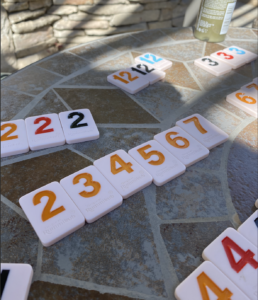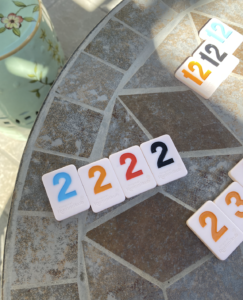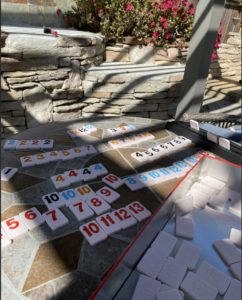Rummikub involves tiles that have numbers and a specific color on them. Players start out with 14 tiles, and their objective is to be the first to have 0 tiles left. Possible actions are for players to put tiles out on the table, drawing a tile if they can’t. Tiles have to be arranged in sets: either the same color with the numbers in a row, or the same number but different and non-repeating colors. Sets also have to have at least three tiles. Players are also able to rearrange the sets already out on the table to accommodate their move.
first way to create a set: same color, contiguous numbers
second way to create a set: same number, different non-repeating colors
The game objects in this game, tiles, are well balanced. Apart from the joker, which can substitute any tile in a set, all tiles have equal importance. However, its importance may be dependent on what tiles the player already has, as well as the arrangement of tiles on the table.
 There are two possible strategies: expend tiles as soon as possible, vs accumulate as many tiles as possible before putting them all down, as the more tiles you have in your hand, the easier it is to create sets. From the times I have played, it seems like the first strategy is what is preferred, as the cost of the latter may be that the state of the tiles that are out on the table may change, rendering your tiles less valuable. Another element that balances out asymmetry in players’ skills is the chance involved in what tiles they draw,
There are two possible strategies: expend tiles as soon as possible, vs accumulate as many tiles as possible before putting them all down, as the more tiles you have in your hand, the easier it is to create sets. From the times I have played, it seems like the first strategy is what is preferred, as the cost of the latter may be that the state of the tiles that are out on the table may change, rendering your tiles less valuable. Another element that balances out asymmetry in players’ skills is the chance involved in what tiles they draw,
Another asymmetry is that players don’ start out with the same tiles (they draw the starting 14 randomly), and one player starts first. However, Rummikub is designed so that your first turn has to individually turn out a set, as well as have the numbers add up to 30 or more. I really like this detail in the mechanics, as it means that players who may start with a really lucky set of tiles will put them out early, reducing the tiles they can work with, and players who have worse tiles will keep drawing tiles (and increasing their advantage once they start playing) until they have better tiles, forcing other players to have to wait for them if they don’t have any more of their own plays.
I really enjoy this game: the more you play, the more you gain an intuition for patterns in the tiles and how to exploit them to what tiles you have in your hand. With certain mechanics such as the starting rules and the chance of the tiles you get, the game is very well balanced while still very engaging as the pace of each game is so different depending on chance!



